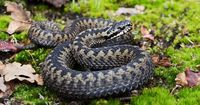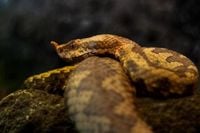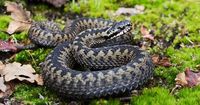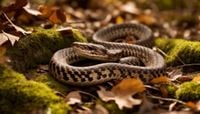As spring unfolds in the forests of Podkarpacie, particularly in the picturesque Bieszczady and Beskid Niski regions, the adder (Vipera berus), Poland's only venomous snake, is becoming increasingly active. This heightened activity is primarily due to the mating season, which occurs at the turn of April and May. During this time, adders are on the hunt for partners, making them more visible to both tourists and local residents.
Edward Marszałek, spokesperson for the Regional Directorate of State Forests in Krosno, notes that while encounters with adders may provoke fear, such concerns are largely unfounded. "The number of adder bites is small," he emphasizes, adding that many snakes fall victim to human actions out of unwarranted fear. These reptiles play a crucial role in the ecosystem, helping to regulate populations of small mammals and other forest creatures.
Identifiable by their distinctive zigzag pattern along their backs, adders come in three color variations: copper-brown, silver-gray, and black. They thrive in diverse habitats, including glades, wetlands, and rocky outcrops at the edges of fields and forests. Interestingly, during winter, they often share their hiding spots with grass snakes and lizards, demonstrating their integration within the local ecosystem.
During the mating season, male adders engage in dramatic displays of strength and agility as they compete for the attention of females. These rituals involve intertwining their bodies and pushing each other to the ground, with the larger male typically emerging victorious. Their activity peaks in the morning when they bask in the sun, increasing the likelihood of human encounters on hiking trails and clearings.
Despite their venomous nature, serious bites are relatively rare, with approximately 20 to 30 reported annually in Podkarpacie. Most bites do not involve the injection of venom, known as 'dry bites.' The risk of fatality primarily affects children or individuals allergic to the snake's venom. In the event of a bite, prompt first aid is essential, including immobilizing the affected limb and seeking medical assistance immediately.
Foresters recommend wearing sturdy, high boots during forest excursions to minimize the risk of bites. It's also advisable to avoid disturbing the underbrush or approaching visible adders. In the case of a bite, the symptoms may not be immediately apparent; pain and dizziness typically set in after 15 to 20 minutes as the venom affects the nervous system.
To protect the adder population in Bieszczady and Beskid Niski, the Regional Directorate of State Forests has initiated an educational program titled "Don't Be Afraid of the Adder." This initiative aims to inform the public about safe coexistence with these snakes. Additionally, warning signs have been installed in areas where adders are prevalent, and buffer zones are recommended around known habitats to reduce human-snake interactions.
As climate change continues to impact wildlife behavior, researchers are noting that earlier emergence from winter dens could disrupt the synchronization between predators like adders and their prey. This highlights the importance of understanding and preserving the local ecosystem.
In Polish folklore, adders have been viewed as symbols of both wisdom and danger. Their presence in the forests signifies a rich biodiversity and a healthy environment. Experts warn that a decline in adder populations can serve as a more telling indicator of environmental degradation than isolated incidents of human bites.
As the spring season progresses, it is crucial to foster ecological awareness and promote safe practices for interacting with nature. By understanding the vital role adders play in balancing rodent populations and maintaining the health of forest ecosystems, individuals can enjoy the beauty of the outdoors while minimizing risks to their health.
In conclusion, as visitors explore the breathtaking landscapes of Podkarpacie, they are encouraged to respect the local wildlife, including the often-misunderstood adder. By taking precautions and participating in educational programs, both people and snakes can coexist harmoniously in this vibrant natural setting.









